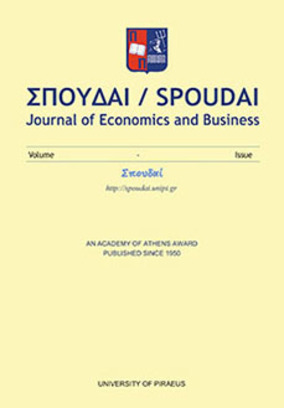Spatial analysis of oil spills from marine accidents in Greek waters
Part of : Σπουδαί : journal of economics and business ; Vol.63, No.3-4, 2013, pages 60-74
Issue:
Pages:
60-74
Abstract:
Greek marine spatial area is located in the Mediterranean Sea with semi-enclosed characteristics. Thus the maritime traffic is undoubtfully significant for political and economic reasons, arousing particular interest unceasingly, because of its specific geographical location, the increasing improvements of freight services and port infrastructure and, the upcoming regional drillings. Marine incidents and accidents that often happen, vary from rather insignificant to serious ones, affecting both humans and environment. This research aims to examine the implementation of a framework analysis of shipping-based oil pollution (accidental and operational) by using spatial analysis and geographical information system. It makes use of data gathered from marine accidents that occurred from 2001 to 2011 in the Greek marine waters. The analysis of the thematic maps introduces firstly marine accidents’ data as points in a dot map. Then, the implementation of spatial analysis approach to mapping these accidents, including the identification of hot spot areas, is elaborated, so that frequency and density might appear versus time over a limited geographical area. This study presents the oil-spills distribution in Greek marine waters through thematic maps and proposes both a methodological and analytical framework for marine accidents evolving into oil spills and combining GIS techniques and spatial analysis.
Subject (LC):
Keywords:
spatial analysis, GIS, oil spills, marine pollution, marine incidents, marine accidents
Notes:
Περιέχει εικόνες και βιβλιογραφία, Special Issue: Management of maritime safety, security and environmental protection
References (1):
- APASA, 2003. A Review of Recent Innovations and Current Research in Oil and Chemical SpillTechnology. RFT AMSA No. 583/28776 (Australia: Asia Pacific Applied Science Associates(APASA) and The Ecology Lab Pty Ltd).Bailey, T. and Gatrell, A., 1995. Interactive Spatial Data Analysis. Longman Scientific & Technical.Burnt Mill. Essex. England. 313p.Bellwood, D.R., Hughes, T.R., Folke, C. and Nyström, M., 2004. Confronting the coral reef crisis.Nature 429: 827-833p.Brown, C., Corcoran, E., Herkenrath, P. and Thonell, J. 2006. Marine and coastal ecosystems andhuman wellbeing. Synthesis. UNEP-WCMC, Cambridge, 65p.Canessa, R., O’Hara, P., Keller, P., Pelot, R. and Serra-Sogas, N., 2008. Visualization of spatial patternsand temporal trends for aerial surveillance of illegal oil discharges in western Canadianmarine waters. Marine Pollution Bulletin. Vol. 56. 825-833p.Carpenter, A., 2007. The Bonn Agreement Aerial Surveillance Programme: trends in North Seaoil pollution 1986-2004. Marine Pollution Bulletin. Vol. 54. 149-163p.Ferraro, G., Meyer-Roux, S., Muellenhoff, O., Pavliha, M., Svetak, J., Tarchi, D. and Topouzelis,K., 2009. Logn term monitoring of oil spills in European seas. International Journal of RemoteSensing. Vol. 30. 627-645p.IMO/FAO/Unesco/WMO/WHO/IAEA/UN/UNEP (Joint Group of Experts on the ScientificAspects of Marine Pollution), 1986. Environmental Capacity. An approach to marine pollutionprevention. Rep. Stud. GESAMP, (30):49p.IMO/Assembly RESOLUTION A.849(20). Code for the investigation of marine casualties and incidents,1997 4-5p.Ivanov, A. and Zatyagalova, V., 2008. A GIS approach to mapping oil spills in a marine environment.International Journal of Remote Sensing. Vol. 29. 6297-6313p.Kulawiak, M., Chibicki, A. and Moszynski, M., 2012. Web-Based GIS as a tool for supporting MarineResearch. Marine Geodosy. Vol. 33. 135-153p.Marven, C., Canessa, R. and Keller, P., 2007. Exploratory Spatial Data Analysis to Support MaritimeSearch and Rescue Planning. Geomatics Solutions for Disaster Management. LecturesNotes in Geoinformation and Cartography. 271-288p.National Research Council, 2003. Oil in the sea III: Inputs, Fates and Effects. National AcademicPress. Washington DC. 265p.Nyström, M., Folke, C. and Moberg, F., 2000. Coral reef disturbance and resilience in a humandominatedenvironment. Trends in Ecology and Evolution 15: 413-417p.Papadopoulos, A., Kallos, G., Katsafados P. and Nikovic, S., (2002). The Poseidon weather forecastingsystem: An overview. The Global and Atmosphere Systems 8 (2-3):219-237.Redland, C.A., 1990. Environmental System Research Institute. 1-2p.Shahrabi, J. and Pelot, R., 2007. Hierarchical Risk-Based Spatial Analysis of the Maritime FishingTraffic and Incidents in Canadian water. Geomaster Solution for Disaster Management,Lectures Notes in Geoinformation and Cartography. 335-350p.Talley, W., Leung, T. and Jin, D., 2012. Determinants of vessel accident bunker spills. Transportation Research Part D. Vol. 17. 605-609p.UNEP. (2006). The state of the marine environment-trends and processes. United Nations Environment Programme and the Global Programme of Action for the Protection of the MarineEnvironment from Land-based Activities (GPA) of the United Nations Environment Programme(UNEP), The Hague. 52p.Volckaert, F.A.M., Kayens, G., Schallier, R. and Jacques, T.G., 2000. Aerial surveillance of operationaloil pollution in Belgium’s Maritime Zone of Interest. Marine Pollution Bulletin 40.1051-1056p.Paris Mou. White-Grey-Black Lists 2009-2011. [On line] Available: www.parismou.org/sites/default/files/PMOU%20WGB%20Flags%20list%202011.pdf[accessed: 23 April 2012].National Port Strategy, 2012. Ministry of Shipping and Aegean. [On line] Available: http://www.hcg.gr/sites/default/files/article/attach/NATIONAL%20PORT%20STRATEGY_%20EL_DEC%202012.pdf [accessed: 15 December 2012].




